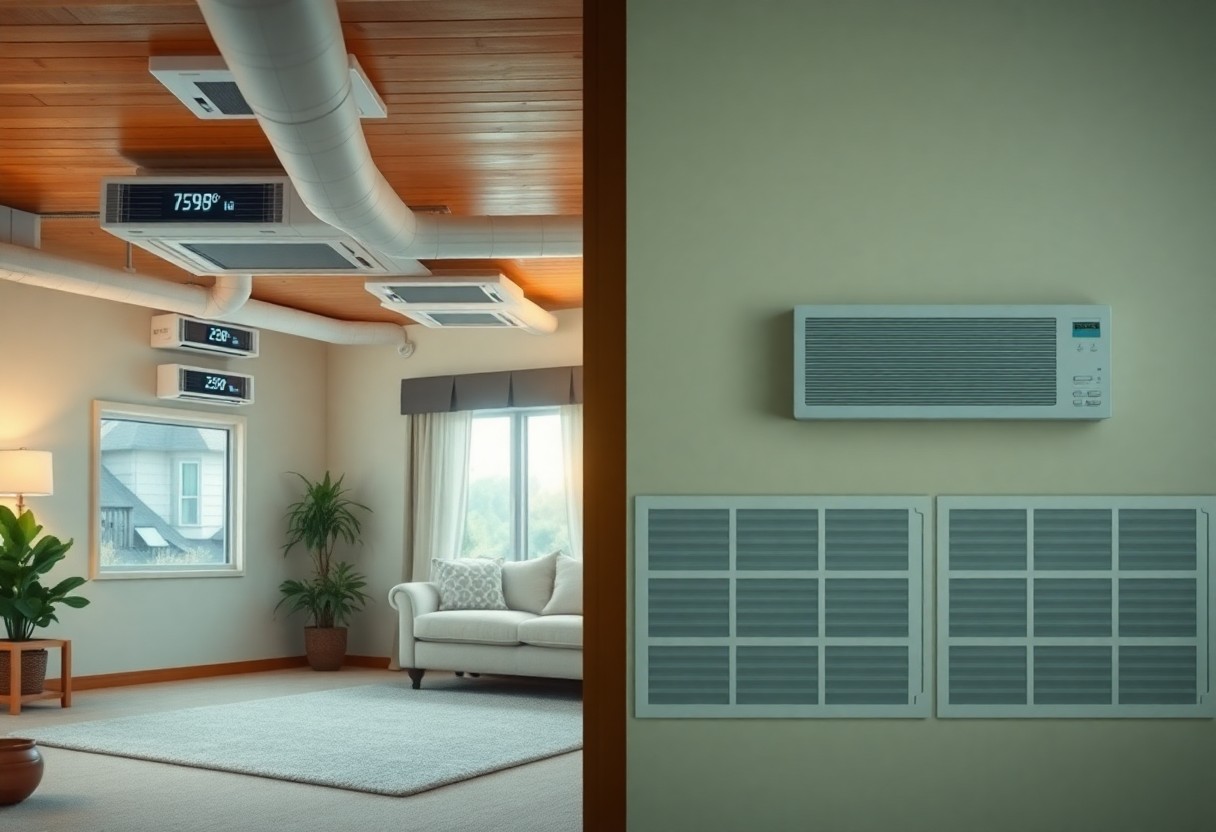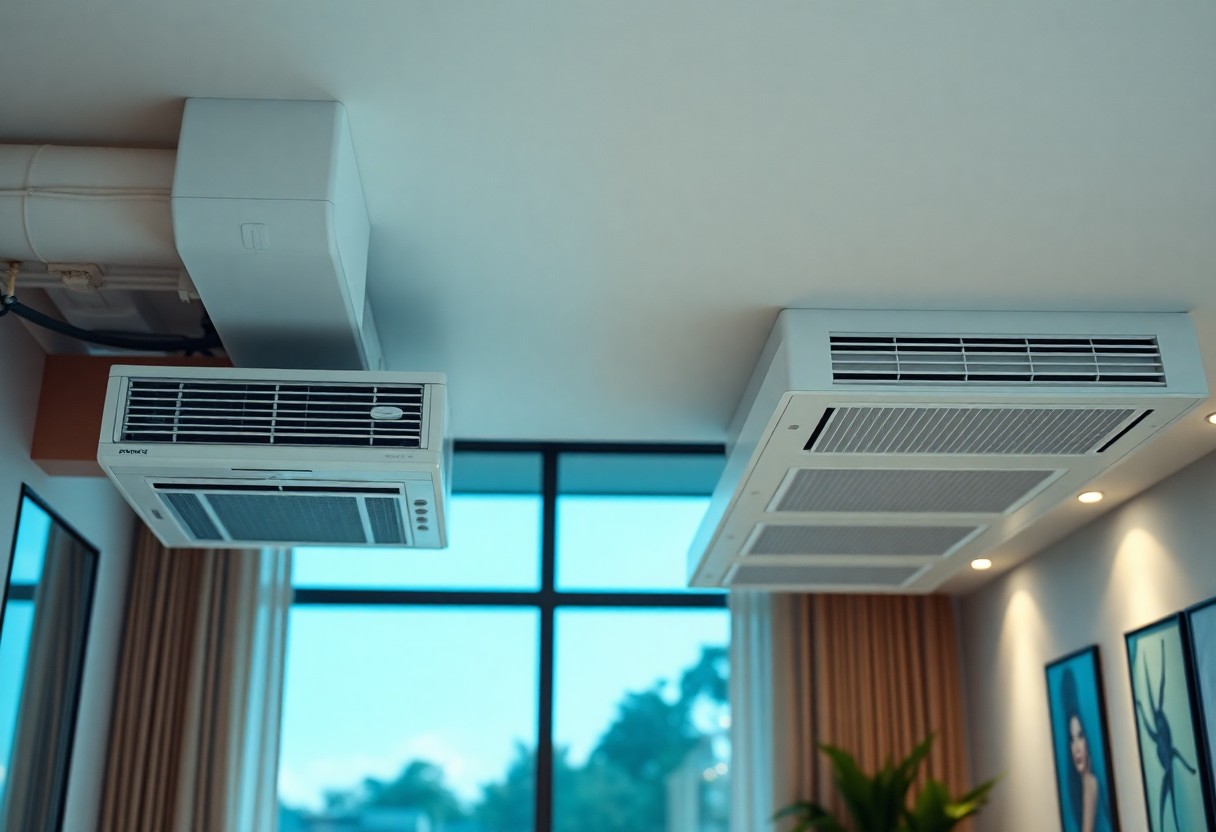Just like picking the right outfit for the weather, selecting between zoned and non-zoned ducted air conditioning can significantly impact your comfort. Understanding the differences allows you to tailor your system to meet your specific temperature control needs. You'll learn how zoned systems enable customized heating and cooling areas in your home, while non-zoned systems deliver consistent temperatures throughout. This guide will help you determine which option best suits your lifestyle and energy efficiency goals.
Key Takeaways:
- Zoned ducted air conditioning allows for individual temperature control in different areas, improving comfort and energy efficiency.
- Non-zoned systems provide uniform temperature distribution throughout the entire space but can lead to wasted energy in unoccupied areas.
- Zoned systems typically require a more complex installation, including additional controls and sensors.
- Non-zoned systems are generally simpler and more cost-effective to install but may not meet varying temperature needs for larger or multi-room spaces.
- Consider long-term energy costs and lifestyle needs when choosing between zoned and non-zoned options for optimal temperature management.
The Core Principles of Ducted Air Conditioning
Ducted air conditioning operates through a central unit that distributes conditioned air via a network of ducts throughout your home. This system is designed to provide comprehensive temperature control, enhancing comfort in multiple areas without the need for individual room units. Utilizing a seamless design, ducted air conditioning ensures that air is evenly distributed, maintaining a consistent temperature across your spaces.
How Ducted Systems Operate
Your ducted air conditioning system begins with a central unit, which cools or warms the air. This conditioned air is then channeled through ducts that run throughout your property. Vents located in each room allow for the selective circulation of air, providing efficient temperature management across various areas of your home.
The Role of Zoning in Temperature Management
Zoning allows you to segment your ducted system into distinct areas or zones, enabling individualized temperature control. Each zone can be adjusted independently based on your preferences or the time of day, leading to improved energy efficiency and comfort. With zoning, you avoid wasted energy on empty rooms and tailor the climate to your family's needs.
| Energy Savings | Reduces energy consumption by conditioning only occupied areas. |
| Personalized Comfort | Allows different temperatures for various rooms based on usage. |
| Easier Control | Offers individual control for each zone through a smart thermostat. |
Implementing zoning strategies in your ducted air conditioning system optimally balances temperature preferences throughout your home. For example, during the day, you might want cooler temperatures in common areas while keeping bedrooms warmer. This tailored approach not only enhances comfort but also leads to decreased energy consumption, allowing you to save on utility bills over time.
| Installation Costs | Initial setup may require additional investment in zoning controls. |
| Maintenance | Zoned systems may need more frequent adjustments and service checks. |
| Compatibility | Ensure your ducted system is compatible with zoning technology. |

The Advantages of Zoned Systems
Zoned systems enhance the performance and efficiency of ducted air conditioning by allowing you to control temperatures in specific areas of your home. This targeted approach avoids unnecessary energy consumption, providing you with comfort in the rooms that matter most while reducing costs in less-used spaces. You can optimize your system based on individual preferences and space utilization, leading to a more satisfying indoor environment.
Energy Efficiency and Cost Savings
Implementing a zoned system significantly boosts energy efficiency, translating to substantial cost savings on your utility bills. By regulating temperatures in specific zones, you prevent wasted energy on unoccupied spaces. Studies indicate that homeowners can save up to 30% on their energy costs by utilizing zoning, making your system not only eco-friendly but also economically beneficial.
Tailored Comfort: Addressing Individual Room Needs
A zoned system provides tailored comfort by allowing you to customize temperatures for individual rooms according to their occupancy and specific usage patterns. For instance, you can keep the living room cooler during the day while maintaining a warmer atmosphere in bedrooms during the night, ensuring that every family member enjoys their preferred conditions.
By integrating smart thermostats within your zoned system, you can further enhance tailored comfort. These devices allow you to set personalized schedules for each zone, adjusting the temperature according to your daily routines. For example, if you often work from home, you can program your office to cool down before you start each day. Such precision not only maximizes comfort but also supports energy conservation, as you avoid heating or cooling spaces that aren't in use. Additionally, with each room's temperature individually controlled, you can easily address any specific preferences or needs of family members, guaranteeing that everyone feels at ease in your home environment.
The Drawbacks of Non-Zoned Ducted Systems
Non-zoned ducted systems provide a single climate control setting for the entire home, leading to several drawbacks that can affect your comfort and energy efficiency. A lack of individual temperature control results in hot or cold spots, making it challenging to maintain a consistent environment throughout your living space. Additionally, these systems often struggle to meet varying temperature preferences among occupants, creating dissatisfaction and discomfort.
Limitations in Temperature Control
The inherent design of non-zoned systems restricts temperature modulation, causing areas within your home to experience significant temperature fluctuations. While the system aims to deliver a uniform climate, it often falls short, leaving certain rooms warmer or cooler than others. This inconsistency can be attributed to factors such as sunlight exposure, insulation quality, and airflow direction.
Temperature Control Limitations
| Inconsistent temperature regulation | Hot or cold spots can develop in different rooms. |
| Lack of individual controls | Entire home is set to one temperature, regardless of preferences. |
| Response time delays | System takes longer to adjust when changes are needed quickly. |
Potential for Energy Waste
Non-zoned systems often lead to greater energy consumption as they operate continuously to try to maintain a singular temperature across your entire home. Without the ability to direct airflow, these units waste energy in less frequently used areas, contributing to higher utility bills and an increased carbon footprint.
For instance, heating or cooling unused rooms while maintaining a comfortable temperature in frequently used areas results in unnecessary power usage. If you live in a multi-level home, maintaining a uniform temperature across all floors can lead to excessive energy cost. Studies show that non-zoned systems can consume up to 30% more energy compared to their zoned counterparts, underscoring the financial impact of inefficient temperature control and energy waste.
Choosing the Best System for Your Space
Assessing your unique space is vital in determining whether a zoned or non-zoned ducted air conditioning system is more beneficial. Your home's layout, insulation quality, and specific temperature preferences play significant roles. A thorough evaluation of these factors will guide you toward the ideal choice, ensuring comfort and efficiency throughout your living environment.
Factors Influencing Your Decision
Several key aspects will affect your decision between zoned and non-zoned systems. Consider the size of your home, the number of rooms, and how frequently you use each space. Additionally, evaluate your budget and long-term energy cost savings, as well as any future remodeling plans you may have. Choices include:
- Home layout and usage patterns
- Initial investment and installation costs
- Potential energy savings over time
Thou must consider these factors to make an informed choice.
Cost-Benefit Analysis of Zoned vs Non-Zoned
Analyzing the financial implications of zoned and non-zoned systems reveals important distinctions. Zoned systems typically have a higher upfront cost due to more complex installations but can lead to significant long-term savings on energy bills. Non-zoned systems, while more affordable initially, may result in higher energy consumption, especially in larger homes where only specific areas require cooling or heating. Balancing the installation costs against potential operational savings is necessary for making the best choice for your budget and comfort needs.

Industry Insights and Future Trends
The ducted air conditioning industry is rapidly evolving, with increasing focus on energy efficiency and smart technology integration. Emerging regulations favor systems that minimize environmental impact, prompting manufacturers to innovate. As consumer demand for customizable comfort rises, zoned systems are expected to become the standard, enhancing both temperature control and energy savings.
Innovations Shaping Ducted Air Conditioning
Recent innovations include variable refrigerant flow (VRF) technology and advanced air filtration systems, significantly enhancing energy efficiency and air quality. Smart thermostats featuring AI-driven algorithms can learn your preferences and adapt accordingly, allowing more precise temperature control in zoned systems. These developments not only improve comfort but are also in line with sustainable practices.
Expert Perspectives on System Evolution
Industry experts highlight a shift towards more sophisticated air conditioning systems that prioritize user experience and efficiency. The integration of IoT technology enables users to control their HVAC systems remotely, significantly reducing energy usage while ensuring optimal comfort at home. This evolution reflects broader trends in consumer technology, making air conditioning systems smarter and more user-friendly.
Experts emphasize the growing importance of energy efficiency and smart-home compatibility in ducted air conditioning systems. As utilities increase incentives for energy-efficient replacements, the transition to advanced zoned systems becomes more appealing. By 2030, projections suggest a 30% reduction in energy consumption for HVAC systems due to emerging technologies, highlighting the urgency for homeowners to consider upgrades that not only save on energy bills but also contribute to a sustainable future. This shift directly impacts your choices in air conditioning, presenting opportunities for enhanced comfort and reduced operating costs.
Conclusion
As a reminder, choosing between zoned and non-zoned ducted air conditioning systems significantly impacts your temperature control and energy efficiency. Zoned systems allow you to manage temperatures in specific areas, offering personalized comfort, while non-zoned systems provide a more uniform temperature across your space. Assess your specific needs, budget, and space layout to make an informed decision that enhances your comfort and promotes energy efficiency throughout your home.
FAQ
Q: What is zoned ducted air conditioning?
A: Zoned ducted air conditioning allows for different temperature settings in various areas or rooms of a home. This system uses dampers to control airflow and can be customized based on individual preferences and usage patterns.
Q: What is non-zoned ducted air conditioning?
A: Non-zoned ducted air conditioning provides a uniform temperature throughout the entire home without the ability to control different areas independently. It operates as a single system that distributes air evenly across all connected spaces.
Q: What are the advantages of zoned ducted air conditioning?
A: Advantages include increased energy efficiency, personalized comfort in different rooms, the ability to reduce energy costs by only cooling or heating occupied spaces, and a more tailored climate control solution for larger homes.
Q: When is non-zoned ducted air conditioning more suitable?
A: Non-zoned ducted air conditioning may be suitable for smaller homes or apartments where maintaining a uniform temperature is sufficient. It can also be more cost-effective in terms of initial installation compared to zoned systems.
Q: Can zoning be added to an existing non-zoned ducted system?
A: Yes, it is possible to convert a non-zoned ducted system to a zoned one by adding dampers and a zoning control system. This upgrade can improve temperature control and efficiency but may require significant modifications and investment.